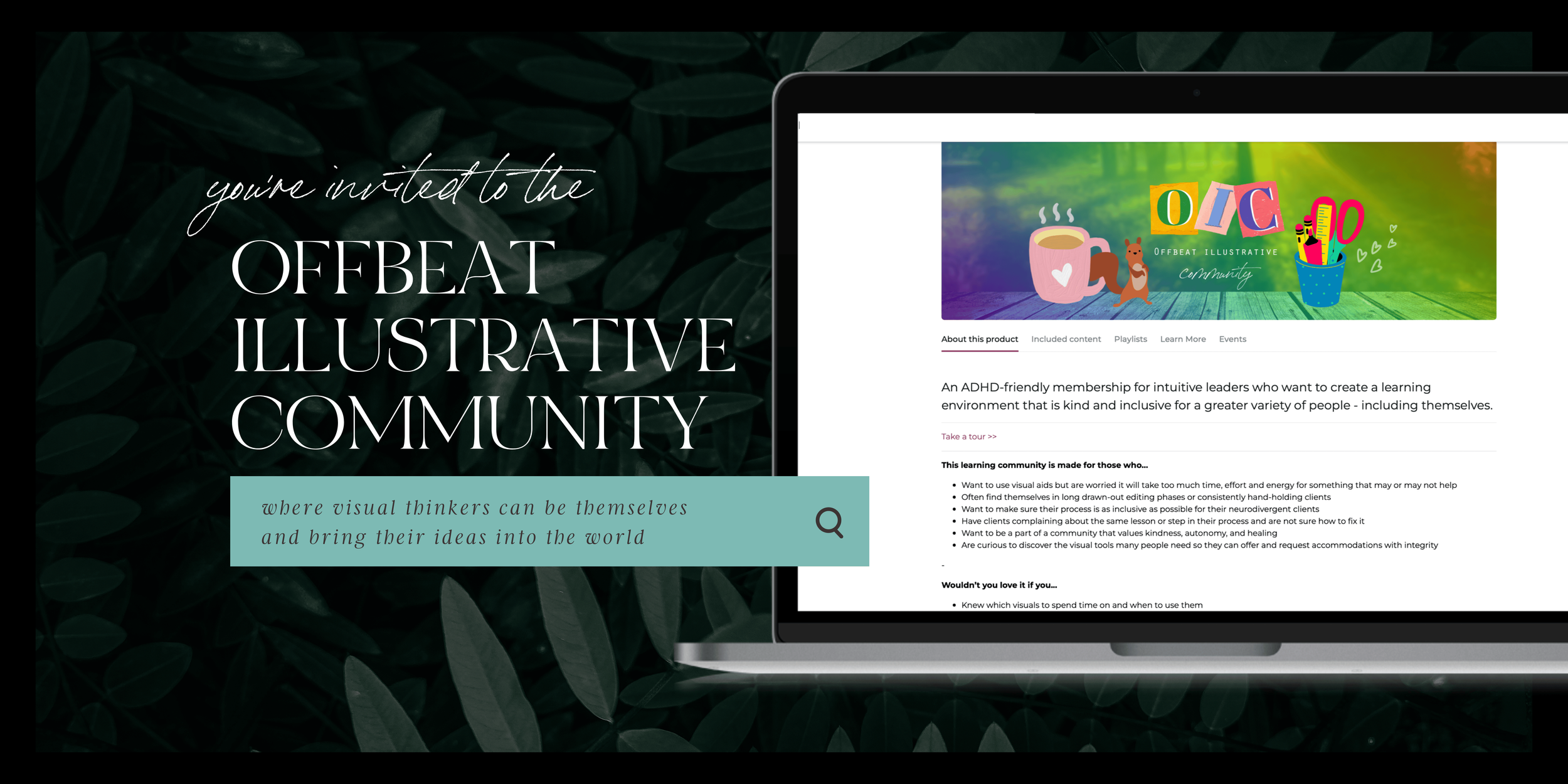The Quiz Results - What Is Your
VISUAL SUPPORT STYLE
The Styles
-
Directors are great at efficiency and action-taking. They are guides for their clients because they’ve been there! Their visual style involves clear action items, prompts, and directive activities/assignments and their motto is "Try this!"
-
Mirrors are great at reflecting their client’s words back in an understandable way. They are a mirror for their client because they can see the best in them! Mirror’s visual style involves reflecting their client’s words back to them and helping them see what they are saying from new angles. The mirror’s motto is “You have your answer!”
-
Luminaries are great at inspiring innovation in their clients. They are cheerleaders for their clients because they can see the limitless possibilities for them! The luminary’s visual style involves inspiring examples, storytelling, and blending options together to make something new. They shatter what others think is possible through the examples they provide. Their motto is “It can be done!”
-
Actors are great at providing a safer space to test things out. They empower their clients because they let their clients explore different options to “try them on” so to speak! The actor’s visual style involves testing and tweaking, thinking of what might happen, role-playing, and acting out scenarios with their clients to see the options available. Their motto is “What could happen if?”
-
Playmates are great at getting their hands dirty to make change in the world. They are servant leaders and allies for their clients because of their willingness to make mistakes and find joy in things! The playmate’s visual style involves playing games, co-working, brainstorming, and checking in on others. Their motto is “Let’s see what happens!”
Director
Mirror
Luminary
Actor
Playmate
psst… if you somehow landed on this page and haven’t taken the quiz yet you can take that here!
The Tools
You can read more about each tool below.
-
• Whiteboards & Visual Brainstorming sessions
• Research-backed infographics & charts
• Explainer videos
• Recorded screen shares
• A Loom video account
-
• Mockups
• Visual Notetaking
• Mood boards
• Vibe checks
• Pinterest boards
• Workbooks/journals
-
• Mockups
• Team/Group artwork
• Real-world examples
• Explainer videos
• Diverse representations
• Visual storytelling
• Vibe checks
-
• Mockups
• Character/Analogy development
• Visual storytelling
• Role-playing
• Demonstrations
-
• Printable/interactive activities
• Games
• Whiteboards
• Visual Note-taking
• Character/analogy development
• Group/team artwork
• Plug-and-play templates
• Pinterest boards
• Interactive sessions
• Message check-ins with GIFs
common types of visual support:
a closer look at
The Tools
-
If your client has a favorite character or story that they mention in the discovery process you can use that as a parallel analogy to what they are working on. For example, I often use the story of Elsa from Frozen 1&2 to decide next steps and what to let go of in a process. Sounds silly but it keeps all of my thoughts organized around a general story - and it's how people have tried to understand things for as long as humans have been around.
-
Having some sort of messaging system with your client is gonna be important so you can play through ideas during the process. You could send something for review with a few choices (like tell me your fave 1, 2, or 3) or offer text/voice message check-ins with animated GIFs to match their answers so they can go back and find it easily. Add a visual reminder to your calendar to send those check-ins if they are something your client needs. (Note: Some clients will NOT want that. They will want you to take care of things behind the scenes - so you can use visual check-ins for yourself if that's the case).
-
Show how to do a task like how to make a recipe or how to fold socks or give an analogy demonstration of a more abstract concept. These are usually pre-recorded and can be shared through a platform like Loom or by using social editors like Reels on Instagram.
-
creating videos ahead of time that show how a process is gonna work will relax anxieties from people who have been burnt by other frameworks that weren't as people-friendly as yours. These take time to make so figure out which ones you'll need based on previous experiences and research.
-
If you're working with a group or people or a team you can gather them together to create artwork that they can keep near them or reference as a reminder that they are supported, in community, and ready to grow/learn together. That kind of mindset is a powerful aid.
-
Mockups are a visual example of how something could look before jumping all the way into a new project. It’s great for costly projects or impulse decisions.
-
This one is pretty commonly used in the branding industry. Having a client put together a private board on Pinterest where they collect images that relate to what you are working on with them (ie: dream life, money goals, outcome goals, branding loves, copywriting faves, etc) will help visual learners share and discover what they like and are aiming for with you.
-
Having a visual framework that someone can work within allows your clients to get creative without losing track of the goal. Taking time to create those templates (most likely based on your signature framework or brand analogies) will save you time and energy later when they need extra support. For example, I’ve created a garden design analogy worksheet for a client to give to their branding clients when planning out marketing together.
-
My mom always taught me that you can learn a lot about a person's character by playing a board game with them. You know that's true in working with clients too. It doesn't have to be a board game though, just playing getting to know you games or getting playful with how you discover next steps is perfect!
-
When you find excellent real-world examples save them somewhere to share easily. Be sure to collect examples from a diverse array of backgrounds and experiences so you have options for everyone you work with or at least know where you can find them.
-
Loom is a great platform for recording yourself or your screen to create videos that are ready to link to in the process. You can save them into folders to organize them and reuse them multiple times or personalize them for a specific client.
-
As you find these charts and infographics save them in a folder to use later. You know the facts (maybe even intuitively) and being able to show them visually to your clients is gonna save you a lot of energy later and get them more fully onboard.
-
Trying on different characters or naming different voices in your client’s head helps the client take their real situation out of the picture so they can compartmentalize or imagine the possibilities for themselves. You can literally play different characters to see how a situation might work out.
-
A vibe check is looking at someone’s goals/brand/website whatever you’re working on together and seeing if it aligns with their personality, values and the environment they wanted to create for their community. Creating a clear vibe at the beginning of working together will help you show this back to them as the journey unfolds.
-
creating a story that someone can think about helps them to see the boundaries of a situation, it’s also a great way to build trust and share how something could look in real life in a digestible way. Think of parables, analogies, and storyboards.
-
A lot of coaches and teachers will take notes about someone's progress but often it's helpful for that person to see it too. You can use online whiteboards and brainstorming platforms to craft the notes and next steps together visually.
-
Creating workbooks and journals with lots of thinking space and prompts that get them thinking and reflecting on their own words and thoughts will help you step back from always being the one reflecting. Craft your workbooks and journals to work in the way that you would in a conversation.
NEW Membership! *
NEW Membership! *
Want to learn more about how to use these tools? Join us in the Offbeat Illustrative Community to access a library full of lessons and a community where you can get feedback and learn with/from each other while honing your visual skills.



















